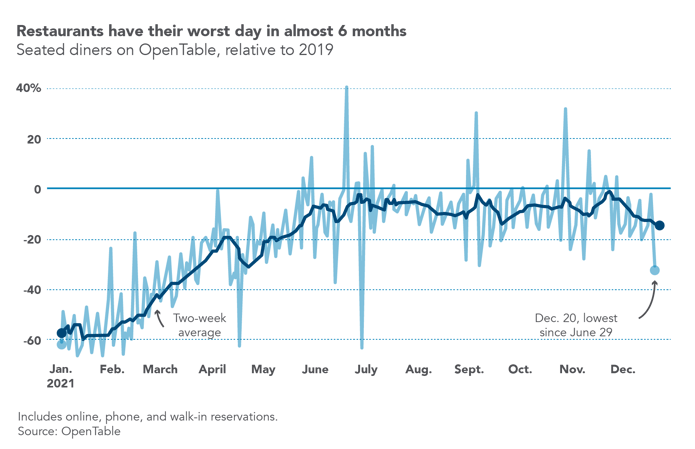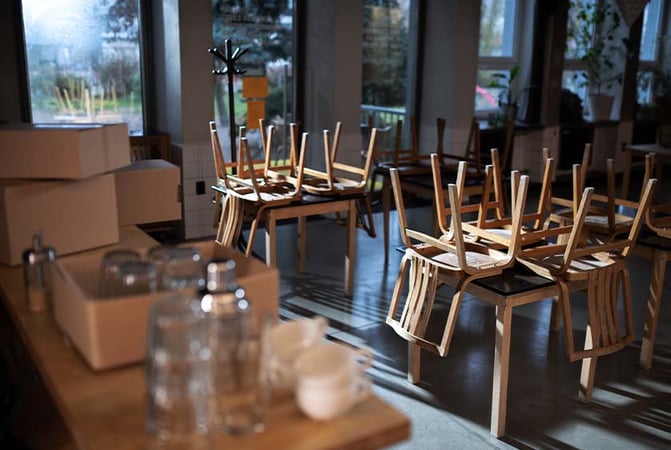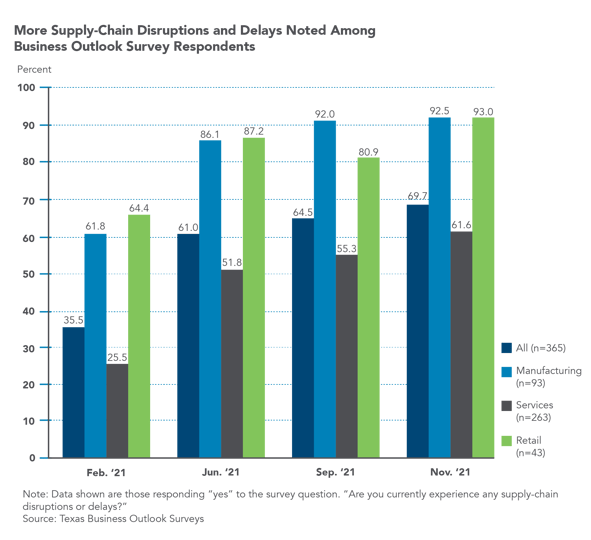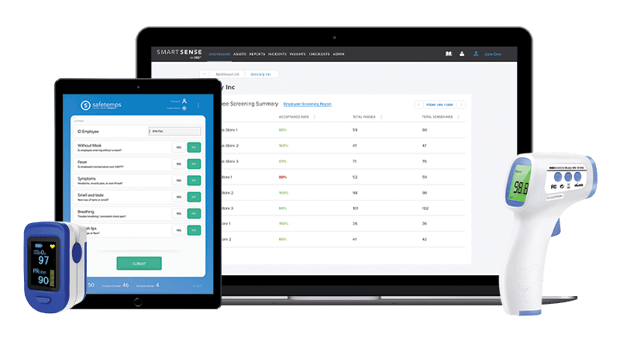Written by SmartSense | Food Safety, Supply Chain, Food Service
Explore solutions built for your industry
Our customer-proven solutions monitor medications and food inventories for some of the most recognizable names in the industries of healthcare, food service, and transportation, and logistics. See how our solutions adapt to your industry needs.
SEE SOLUTIONSKroger Health Strengthens Compliance Visibility with SmartSense
Watch The VideoLEARN
Questions? Call +1 (866) 806-2653 to speak to our experts.
Schedule demoQuestions? Contact us.
Call +1 (866) 806-2653 to speak with our experts or get started with a demo.
CONTACT USAbout Us
SmartSense was created to use the power of the Internet of Things (IoT) to help our customers protect the assets most critical to the success of their business.
See our storyCONNECT. PROTECT. RESULTS.
Questions? Call +1 (866) 806-2653 to speak to our experts.
Schedule demoPlease select your login
February 17, 2022
Restaurants Need a Digital “Booster”
The coronavirus pandemic has accelerated the digital transformation of the food service industry faster than anyone had ever predicted. Adoption of IoT technologies, such as remote sensors, analytical software, and omnichannel delivery platforms have been immensely helpful to alleviate the ongoing customer behavior changes, labor shortages, and supply chain issues. That’s all great news. But there’s still more we can do.
Why? The pandemic is still with us, for the long term, as are the same problems and obstacles. During year one of the coronavirus pandemic, Covid-19 disrupted the restaurant industry to an extent not seen since WWII. During year two, just as vaccines were administered, restrictions on indoor dining eased, and customers started returning to their favorite dining rooms, new variants surfaced and stalled all hopes for a fast recovery.
Now, approaching year three, after booster shots temporarily improved prospects for a return to a semblance of normalcy, omicron has spread like wildfire and threatens to reverse any progress made since the pandemic broke in March of 2020.

SOURCE: https://www.washingtonpost.com/business/2021/12/24/workers-outbreaks-omicron-restaurants/
No doubt, as we enter 2022, it’s more than likely we’ll see a continuation of the current issues plaguing restaurants today brought on by the ongoing pandemic: an upsurge in infection rates, labor shortages, supply chain disruptions, and price increases.
Here are a few concerning statistics:
-
More than 90% of restaurant managers said they ran into product delays or shortages in the past three months, according to a survey by the National Restaurant Association (NRA).
-
The US Bureau of Labor Statistics (BLS) found that prices for food away from home increased 7 percent during the past year.
-
According to the Independent Restaurant Coalition, 60 percent of adults had already changed their dining habits due to the delta variant even before the appearance of omicron.
Canceled reservations are once again clearing out dining rooms in restaurants hobbled by COVID-19 restrictions, including new proof-of-vaccination mandate in many cities. According to OpenTable, customer concerns over the omicron variant have caused table reservations to drop 48% in New York City, 39% in Chicago, 34% in Baltimore, 29% in New Orleans, and 21% in Denver compared to the same timeframe in 2019.

Closures are rampant. The NRA reports that more than 90,000 restaurants and bars have shuttered since the start of the pandemic. Even huge national chains, including McDonald’s, have closed locations because of hiring challenges. And more than 86 percent of restaurant owners are worried that they’ll have to close in the near future without additional grants from the Restaurant Revitalization Fund.
Heightened competition within the foodservice industry for a diminished customer base will force restaurants to stay as flexible as possible. Learning lessons from 2020 and 2021, owners and managers must stay up to date on current technological advancements and digital solutions that can help streamline on- and off-premise operations and improve efficiency.
Fortunately, the SmartSense digital solution can monitor your inventory that is hard to get, replace some of the labor of workers you can’t recruit, and verify the health of workers you do currently have on staff.
Inventory Data Used to Minimize Supply Chain Disruptions
In 2022, restaurants will continue to grapple with disruptions to US food supply chains. Essential food service products, both food, and packaging such as chicken and aluminum, may be out of stock or priced beyond profit margins. That means jeopardizing a menu’s signature dishes, compromising the quality of meals during delivery, and generally disappointing a loyal customer base.
In addition, shortages of essential equipment, such as HVAC units, and their replacement parts will require ongoing monitoring and maintenance of existing inventories to prevent failure and food safety risks. Fortunately, the internet of things (IoT) and digital technologies can help automate many aspects of supply chain management.

SOURCE: https://www.dallasnews.com/business/retail/2021/12/28/2022-look-ahead-how-long-will-supply-chain-issues-persist-in-the-new-year/
Restaurant Labor Shortage Statistics
Restaurants will also continue to struggle with the number one issue now at the forefront – labor. Hiring and retaining employees—always a challenge for the foodservice industry—has been much more difficult during the pandemic.

When many restaurants initially closed in 2020, laid-off staff found employment in other industries. Convincing former employees to return has been a huge challenge, given reduced hours and tips, as well as risks to their own safety from potential infection and angry customers sometimes violently objecting to mask and vaccination mandates.
The latest available data from the BLS demonstrate the problem:
-
A record of nearly a million employees quitting altogether
-
750,000 fewer restaurant and bar jobs
-
A near-record 1.7 million open jobs in leisure and hospitality
Simply put, restaurants cannot find the labor needed to operate at 100% efficiency and productivity. In a recent NRA survey of 3,000 US restaurant operators, 77 percent said they didn’t have enough workers to meet demand.
Managers lack the tools to properly schedule employees, especially during upsurges of infection. As a result, businesses are paying for redundant overworked labor, floundering with inadequate labor, and unwittingly scheduling Covid-positive employees, thus putting customers and coworkers in jeopardy.
Until the labor shortage is rectified, restaurants will be unable to operate at full capacity, forcing them to either change their working conditions or their business models to survive. Hiring will surely become more competitive. In response, restaurant owners will be wise to implement any form of technology that helps them overcome labor issues by replacing hours in the labor schedule with automated functions.
The SmartSense Solution: Restaurants Reopen with Sensor Technology
As we discussed in a previous post, the pandemic dramatically accelerated digital transformation of the food service industry. Omnichannel technology providing actionable data and insights to create personalized, safe, and accessible customer experiences is no longer “the next big thing.” We’ve passed the tipping point. Digital is no longer a “good to have” but a “must-have.” That’s where SmartSense can help. We offer a portfolio of automation tools enabling restaurants to optimize their business and do more with less.
Remote Monitoring Helps Monitor and Secure Restaurant Inventory
Moving forward, consumer demand for more supply chain transparency will drive restaurants to adopt digital technology solutions to automate the management of heating, cooling, freezing, ventilation, and air conditioning units. Using advanced sensors and cloud-based diagnostics, food service operations can reduce energy consumption and the frequency and magnitude of expensive equipment replacements and repairs.
In terms of food products, adoption of digital inventory planning and forecasting will help synchronize supply and demand, mitigate uncertainty, foster cost control, ensure safety, and reduce waste. As restaurants embrace new ways to drive revenue, such as more takeout and delivery options, more inventory in the “hold and chill” and “hold and heat” categories must be monitored to prevent temperature excursions and potential outbreaks of foodborne illness.
Restaurants are also operating with limited hours, leaving food inventory unmonitored for more hours per day. Imagine arriving at your restaurant before sunrise to discover the walk-in cooler has warmed to 55° -- you have no choice other than to throw all this valuable inventory away. The average walk-in cooler holds products worth thousands of dollars, not to mention the lost revenue for not having product to serve your customers. With an automated monitoring solution, you would have been alerted as soon as the temperature excursion was detected, giving you time to take critical action.
By digitizing and automating procedures, restaurants will realize several benefits. Digital systems reduce errors and train employees to know how to correctly complete a task when excursions occur by quickly completing workflows to drive compliance. They also provide insight into who is doing a great job and who needs a little more coaching on safety and quality at every step, from receiving a delivery to preparing food on a hot or cold service line.
Automating Environmental Condition Data Collection to Redirect Employee Labors Hours Toward Customer Service
Considering that most restaurants continue to be understaffed, how can management get more productivity out of fewer people? With leaner teams and limited resources, restaurants must prioritize investing in technology that will optimize operations and help team members maximize time and efficiency while continuing to deliver a premium customer experience.
IoT solutions are proven to alleviate workload demands on staff. They automate many transactional processes of the dining experience, allowing staff to focus on more customer-facing tasks. This enables employees to redirect labor from the time-consuming duties of manual temperature monitoring and offer attentive customer service.
While health inspections may have slowed during the pandemic, safety managers must still meet the requirements outlined in their critical control points plan. With digital, continuous, remote monitoring, they no longer have to rely on labor hours to check and record equipment temperatures.
Restaurant owners can save an average of 3 to 5 minutes per temperature check, given that a typical restaurant has anywhere between 6 to 8 pieces of equipment and that employees check equipment 2 to 4 times per day. That translates into saving more than 2 hours per shift that can now be directed toward customer service.
How IoT Data Improves Employee Safety
A main reason for the labor shortage is the risk of virus exposure that customer-facing employees deal with every day. More than 50,000 have been infected or exposed to the coronavirus, according to the United Food and Commercial Workers' Union. With new variants rapidly spreading across the country, restaurant owners are caught between the horns of a dilemma: weighing the safety of staff and customers against the financial costs of temporarily shutting down.
For example, Dennis Ngo, chef-owner of Di An Di in Brooklyn, discovered that business had dropped 40% when he closed his restaurant for several days after finding out an employee had been exposed to the coronavirus. Part of the problem was the lack of access to rapid tests. “If testing were abundant,” Ngo said, “we could get answers immediately. I would have hoped we’d be better prepared this time around.”
How Safetemps Works

It’s precisely to help restaurants reopen amid the COVID-19 outbreak that SmartSense developed Safetemps—a scalable, cost-effective health screening solution that provides visibility into employee wellness. In just 10 seconds, managers can identify potentially sick employees using a configurable digital questionnaire and touchless infrared thermometer.

Results are captured digitally and available in enterprise-wide reporting tools. This data allows organizational leaders to roll information up across locations and geographies in real-time to better understand the health of their workforce and its impact on their business.
The pandemic has made it loud and clear: digital is the new normal. There’s no going back. Restaurants must continue to adopt IoT technologies to deliver the satisfying experiences customers have come to expect, whether in the dining room or at home waiting for delivery.
SmartSense is here to help with innovative automated solutions that enable your restaurant operation to focus on better customer service and maximize revenue during these challenging times.
Other Suggested Posts
Why Customer Success Makes the Difference in Your Condition Monitoring Program
If your business objective is to implement an efficient and successful condition monitoring program, gone are the days of “set it and forget it.” Today’s savvy ...
Why K-12 School Cafeterias Are Automating Food Safety
During the COVID-19 pandemic, there were significant disruptions to K-12 school food services nationwide. School nutrition directors were forced to rapidly ...
Frozenomics: Why Freezers Are Becoming America's Financial Lifeline
When times get tough, Americans get creative with how they stretch budgets. That's why today's shoppers are fighting inflation and financial strain with an ...
How Machine Learning Elevates Traditional Temperature Monitoring
While a minority of food companies and healthcare organizations continue to manually collect temperature logs to meet compliance regulations, most enterprises ...
Creating a Customer-Centric Food Chain with Sensing-as-a-Service
The food service industry is undergoing an era of labor uncertainty and demand volatility. The reasons are many and complex: the rise of e-commerce, supply ...
Subscribe to the SmartSense Blog
Stay up-to-date on the evolution of IoT connectivity.
CONNECT. PROTECT. RESULTS.
Learn how our complete critical
environment monitoring solution will help you
connect and transform your business.
Call +1 (866) 806-2653 to speak with our industry
experts or get started by
requesting a demo.